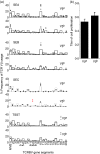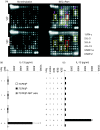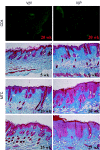Impact of T-cell receptor Vbeta haplotypes on the development of dermatitis in DS-Nh mice: synergistic production of interleukin-13 caused by staphylococcal enterotoxin C and peptide glycans from Staphylococcus aureus
- PMID: 17313488
- PMCID: PMC2265923
- DOI: 10.1111/j.1365-2567.2007.02536.x
Impact of T-cell receptor Vbeta haplotypes on the development of dermatitis in DS-Nh mice: synergistic production of interleukin-13 caused by staphylococcal enterotoxin C and peptide glycans from Staphylococcus aureus
Abstract
Although the pathogenic role of interleukin-13 (IL-13) is a key for atopic dermatitis (AD), the mechanism of IL-13 production in AD remains unclear. To investigate the role of the T-cell receptor Vbeta (TCR Vbeta) haplotype in the development of dermatitis and the production of IL-13 in the naturally occurring dermatitis model by staphylococcal enterotoxin C (SEC)-producing Staphylococcus aureus, we raised DS-Nh mice harbouring the TCR Vbeta(a) haplotype with a central deletion in the TCRBV gene segments, including TCR Vbeta8S2. Observation and histopathological analysis of the two mouse substrains with spontaneous dermatitis indicated that later onset and weaker severity of AD-like dermatitis were identified in mice with TCR Vbeta(a) compared to those with TCR Vbeta(b). Immunohistochemical examination revealed the infiltration of a large number of CD4-bearing T cells in the skin lesions in mice with TCR Vbeta(b) but not in those with TCR Vbeta(a). Interestingly, much lower levels of serum IL-13 were detected in mice with the TCR Vbeta(a) than in those with the TCR Vbeta(b) haplotype. In vitro, synthetic ligands (Pam(2)CSK4) of toll-like receptor 2 (TLR2) synergistically produced IL-13 with SEC in splenocytes of mice with TCR Vbeta(b) but not of those with TCR Vbeta(a), and natural killer T cells were essential for this synergism. Our findings suggested that this TCR Vbeta-haplotype-dependent synergism with TLR2 plays an important role in the development of AD-like dermatitis in DS-Nh mice.
Figures







Similar articles
-
Association of T-cell receptor Vbeta haplotypes with dry skin in DS-Nh mice.Clin Exp Dermatol. 2009 Jan;34(1):61-7. doi: 10.1111/j.1365-2230.2008.02921.x. Clin Exp Dermatol. 2009. PMID: 19018787
-
DS-Nh as an experimental model of atopic dermatitis induced by Staphylococcus aureus producing staphylococcal enterotoxin C.Immunology. 2003 Apr;108(4):562-9. doi: 10.1046/j.1365-2567.2003.01588.x. Immunology. 2003. PMID: 12667219 Free PMC article.
-
Effects of TNCB sensitization in DS-Nh mice, serving as a model of atopic dermatitis, in comparison with NC/Nga mice.Int Arch Allergy Immunol. 2005 Feb;136(2):173-80. doi: 10.1159/000083326. Epub 2005 Jan 12. Int Arch Allergy Immunol. 2005. PMID: 15650316
-
A human-SCID mouse model for allergic immune response bacterial superantigen enhances skin inflammation and suppresses IgE production.J Invest Dermatol. 1998 Mar;110(3):224-31. doi: 10.1046/j.1523-1747.1998.00119.x. J Invest Dermatol. 1998. PMID: 9506440 Review.
-
Staphylococcus aureus enterotoxin mediated specific non-responsiveness of human T cells.Immunol Lett. 1991 Oct;30(2):165-70. doi: 10.1016/0165-2478(91)90020-b. Immunol Lett. 1991. PMID: 1684571 Review.
Cited by
-
Role of TRPV3 in immune response to development of dermatitis.J Inflamm (Lond). 2009 May 25;6:17. doi: 10.1186/1476-9255-6-17. J Inflamm (Lond). 2009. PMID: 19463197 Free PMC article.
-
Toll-like receptors in atopic dermatitis: pathogenesis and therapeutic implications.Heliyon. 2025 Jan 31;11(3):e42226. doi: 10.1016/j.heliyon.2025.e42226. eCollection 2025 Feb 15. Heliyon. 2025. PMID: 40007792 Free PMC article. Review.
References
-
- Leung DY. Atopic dermatitis: New insight and opportunities for therapeutic intervention. J Allergy Clin Immunol. 2000;105:860–70. - PubMed
-
- Leung DY. Infection in atopic dermatitis. Curr Opin Pediatr. 2003;15:399–404. - PubMed
-
- Akira S. Toll-like receptors: lessons from knockout mice. Biochem Soc Trans. 2000;28:551–6. - PubMed
MeSH terms
Substances
LinkOut - more resources
Full Text Sources
Molecular Biology Databases
Research Materials
Miscellaneous

